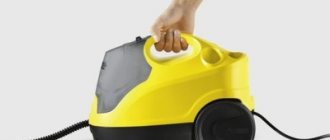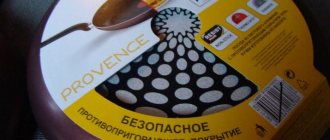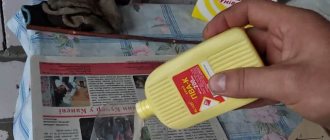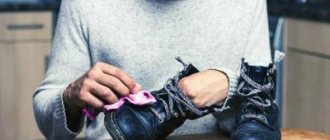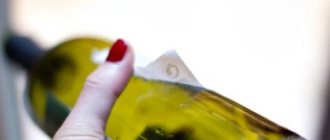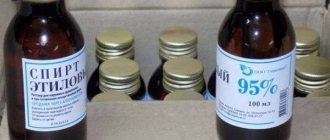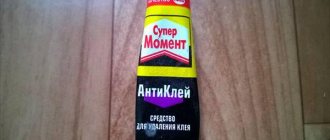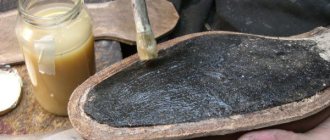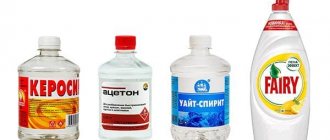Who doesn’t know about PVA glue, which is actively used for gluing products from various types of materials: wood, ceramics, chipboard, linoleum, paper, glass, fabric and leather bases. The popularity of the glue is determined by the high-quality adhesion of the material and the surface to be glued, its affordable cost, increased resistance to moisture, but, at the same time, good solubility in water, which in itself answers the question, how to dilute PVA glue? The purpose of the glue is determined depending on its type.
PVA glue is the most popular substance in the world. It is universal and will be useful both when studying at school and when carrying out repairs in a house or apartment.
Main types of PVA glue
The main types of PVA glue compositions, divided into types according to purpose, include:
- stationery - for gluing paper and cardboard bases;
- wallpaper or household - for gluing paper materials to wooden and cemented surfaces;
- construction – for fiberglass, paper and vinyl compounds. Serves as an additive for primer compositions, which helps improve the technological properties and adhesion of subsequently applied materials: putty, plaster, dry mortar;
- super M – indispensable for gluing products made of vapor-proof materials, ceramic and porcelain products, fabrics, glass, leather. In addition, it is used when installing a variety of floor coverings;
- Extra - used for gluing wood, plywood, construction mesh, wallpaper (cork, vinyl, paper, fiberglass), sickle. Used as an additive to improve strength;
- Universal – useful for gluing paper and laminated paper decorative plastic to wood, glass and metal surfaces.
Can PVA be diluted with water?
The very idea of diluting too thick glue with water did not come out of nowhere. This is all explained by the fact that it contains water.
The answer to the question is yes. This is one working way to reuse thickened glue.
When salvaging glue, you should use warm water (about room temperature) when diluting the PVA. If the liquid is too cold or too hot, the composition will lose most of its technical characteristics, and the seam after gluing with “saved glue” will be unreliable.
As for the proportion of components, it should be approximately 1:10. The amount of glue should exceed the amount of diluted liquid by 10 times.
Source sdelai-lestnicu.ru
If you increase the amount of liquid, your mixture will lose its gluing effectiveness. For example, they will no longer be able to connect wooden parts - the glue simply will not hold.
If your glue has not been used for a long time and has thickened, then before adding liquid to it, you need to remove the crust that has formed on the surface. Glue lumps that resemble jelly do not need to be removed. When thoroughly mixed with water, they will dissolve into the mixture.
When diluting office glue, do not use alcohol or acetone. If they are part of the newly formed mixture, then there is a possibility that these substances will corrode the surfaces being connected.
However, not all types of glue can be diluted with water. Yes, if it is a household or office type of PVA that has simply thickened, then you can try diluting it with water in a ratio of 1 to 10. In this case, super-M or universal PVA cannot be diluted in any way - just throw it away and replace it. But if the glue has dried, then you can only throw it away and buy a new one.
Source dm.henkel-dam.com
To thoroughly mix the composition with water, you must:
- First of all, prepare the container;
- Afterwards, pour glue into it, and then add water in a certain proportion;
- The mixture must be stirred until you obtain a homogeneous white mass;
- The last step is to simply let the composition sit;
- You cannot use the solution immediately after mixing - there is a risk of damaging the product being glued. The mixture of glue and water should be left alone for at least half an hour.
If you use glue as a primer to increase the adhesive properties of walls before painting, then the proportion of water to glue should be 2 to 1 (there should be twice as much water as glue). As a result, you should have a liquid white mixture.
In all other cases, the amount of water added should be less than the adhesive mixture.
You also have the option of making the adhesive mass yourself. It is made from starch or wheat flour and water. And the first thing you need to do is pour starch powder, flour or a mixture of them with cold water. Next, you need to boil water in a separate container. After boiling, a cold solution with starch and flour is gradually added to the container. Next, you need to continuously stir the mixture for 10 minutes or more.
The result should be a jelly consistency.
Source kraskaguru.ru
Is it possible to dilute the glue and with what?
So, we come to a question that interests many: how to dilute PVA glue? Let us hasten to answer – yes, it is possible. You just have to do it right. How to cope with such a seemingly simple task and not spoil the glue, read on.
In order to cope with the task, try to adhere to some recommendations and dilute the glue only with warm water; various types of solvents negatively affect the technical properties and structure of the composition, destroying it. In this case, it is necessary to mix the glue as intensively as possible.
Features of dilution of specific varnishes
When diluting matte varnish or enamel with glitter, the question arises about what products can be used in this case. It is worth considering all suitable options.
How to dilute glitter polish
It is allowed to dilute varnish with glitter using both special thinners and folk remedies. They have no effect on the glitter. They do not change their color or fade.
Thinner for matte varnish
The matte version is no different from the glossy one. To restore it, it is allowed to use similar means. But it should be borne in mind that this coating is very capricious.
It is not recommended to experiment with it, so the choice should be made with special thinners.
How to dilute the dry mixture
You already know how and with what to dilute PVA glue in its usual form, but sometimes you have to work with a dry mixture. Such substances are diluted according to the proportion or ratio indicated on the packaging. The manufacturer recommends that you adhere to these recommendations, otherwise the glue will lose its technical properties and will be useless for gluing.
As a result…
PVA glue is an extremely useful thing; it can be used almost anywhere. However, it tends to thicken quickly upon prolonged contact with air. But don't despair if your glue has become thicker. At any time, you can simply dilute it with warm water in a ratio of 1 to 10. If you have super-M or universal PVA, then they can be diluted with vinegar or acetone.
Question
Write in the comments what you think - is it still possible to “save” the glue if it has completely dried out?
An exception
If 90% of types of PVA glue can be diluted with water, then 10% falls into a special category of adhesive compositions that are present on the market and cannot be diluted with water. They are usually presented in ready-made form: in a diluted state and in appropriate containers, since they are characterized by an unpleasant chemical odor, and the substance dries out quickly in open cans. To prevent the glue from hardening, try to buy containers that are large enough to apply the glue at one time. This will save both glue and money.
There are exceptions when such glue is diluted, but only with the use of a special synthetic solvent.
Why can't it be diluted with water?
There is a lot of information on the Internet that states that the following types of PVA glue cannot be diluted with water:
- extra M;
- building;
- domestic.
The information is completely true, because it’s all about the chemical composition of the listed types of glue. When it reacts with water when a person tries to mix the glue, significant changes occur. As a result, PVA loses its original adhesion quality, because the chemical structure of the glue is destroyed.
To find out which types of glue cannot be mixed with water, you should pay attention to the appearance and smell. The glue contained in large jars closed with a tight lid, which has a specific unpleasant odor, should not be mixed with water.
If such PVA glue has thickened, it should be disposed of, because it no longer has the chemical properties and qualities we need.
How to properly apply diluted glue to a surface
So, having figured out how to dilute thick PVA glue, working with it does not involve any difficulties. It's quite simple. The presence of instructions will simplify the task, since the insert contains brief information about what this or that type of product is used for gluing and how to use it correctly. Since the use of glue for wood and paper is somewhat different, some people face problems when gluing wooden surfaces. To prevent unpleasant moments from happening to you, remember a simple rule: apply glue to the side of the product that absorbs the composition more slowly, that is, with a less porous structure.
Main varieties and features
Depending on the composition, PVA glue may have different abilities and characteristics that are strikingly different from each other.
The correct concentration of adhesive can be achieved by mixing different components, however, the characteristics of such adhesive can vary greatly. In order to choose the most suitable adhesive for your type of work, it is worth considering all the available options on sale.
Domestic
In everyday life, PVA can be used for finishing work, because it adheres well to walls when painting brick, concrete, plasterboard and plaster. Its use is quite simple; the glue is suitable even for gluing wallpaper or wood, because it easily bonds wallpaper to the surface.
This type of glue appears on sale in large volumes, measured in liters. This volume is sufficient for long construction work in which it is necessary to glue foam rubber, paper or textiles to heavy surfaces.
Recommendations for applying glue
Is it possible to dilute PVA glue with water? We figured it out. Remember that when working with PVA glue, regardless of the type, follow some rules:
- to apply glue to thin wallpaper, one layer of the product is enough, and for dense materials - two;
- for spot application of PVA, a special nozzle is used, and if it is not available, they use improvised means - a syringe without a needle or an ordinary pipette;
- to treat a large surface use a sponge or roller;
- apply glue starting from the center and gradually moving to the edges;
- glued objects, if possible, are kept under pressure for greater reliability.
After studying the information provided in the article, you received an answer to the frequently asked question: “how to dilute PVA glue?” Taking into account the recommendations given, the use of glue will be a rational solution for you if you need to connect any parts together.
Prepare the primer yourself
How to make a mixture that has the properties of a primer? You need to take the following components:
- PVA glue – 1 part;
- water – 2 parts;
- cement - the amount is determined by the density.
The preparation technology is not difficult: the glue is diluted with water, mixed, and the required amount of cement is added. The finished solution should resemble liquid sour cream and fit well on the surface.
Diluted primer is an excellent, economical means of preceding the treatment of walls with wallpaper glue, but is not sufficient for a reliable finish. Is it possible to improve the quality of the primer composition? Repair experts advise adding crushed chalk and liquid resin to the mixture with PVA glue. Their mass should not exceed 5% of the total volume of the composition.
Important cooking conditions:
- Work on creating a primer should be carried out in a warm room, away from drafts and sources of fire.
- Use convenient containers: a large bucket, a basin, a canister with a wide neck.
- Water is added to the glue gradually, the classic ratio is 2:1.
- Constant stirring of the composition will prevent the formation of a surface water layer. To facilitate labor and obtain the greatest homogeneity, you can use a construction mixer.
Priming walls with glue is different in that it forms a film on the treated surface without filling small cracks and gaps. But, given the relatively low cost of the components used, the result is an excellent building material that can be quickly made at home.
On video: deep penetration primer made of PVA.
Bitumen mixtures
Bituminous varnish is a mixture of a special grade of bitumen, various resins and oils. After drying, a durable black film is formed on the surface, moisture-resistant and impervious to chemical attack. It is considered a fairly new material in household use. Belongs to the inexpensive category. It is often used as an anti-corrosion protective layer.
For wooden surfaces it is used when there is no need to emphasize the natural texture of the base (instead of paints). Bituminous material has found application as a decorative coating for the effect of aging surfaces (patina). Another unique feature of bitumen mixtures is cold gluing. The bitumen solution is diluted with white spirit.
To prevent it from thickening during storage, the container must be airtight. The storage location should be dark (without direct sunlight), with moderate temperature and humidity.
Bituminous varnish protects the surface very well from moisture and chemical influences, diluted with white spirit
Modern products and concentrates
Modern chemicals that can cope with the task quickly, without spoiling the quality of the item, will help remove an untidy glue stain.
PVA glue is an emulsion of polyvinyl acetate in water. It is supplied for cleaning, so there are no unnecessary difficulties in the process. However, this only applies to a fresh glue stain: just moisten it generously with water, rub it, and the stain will immediately come off. But you will have to work hard on the dried one.
Effective means are: medical alcohol, vinegar, acetone, gasoline, turpentine, ammonia, baking soda, petroleum jelly, white spirit, Dimexide. The following oils performed well: baby oil and sunflower oil.
"Dimexide" is not only an anti-inflammatory drug that can be bought at any pharmacy, but also a good solvent, and it is inexpensive.
You need to soak a napkin or cotton pad with the solution, apply it to the stain, and leave it to soak for half an hour. After time has passed, remove the residue with a damp cloth and, if necessary, rinse with water. We must remember: “Dimexide” is an aggressive substance, so you need to wear rubber gloves when working with it, and you should avoid getting drops into your eyes, mouth or open wounds. Another caveat: this solvent can damage painted items, so it should be used carefully on clothing. This is especially true for denim.
If you don't have solvent on hand, you can use the freezer compartment of your refrigerator. Place the item that requires cleaning and leave it for 5-6 hours. At temperatures below -10 degrees, the glue becomes very brittle, so it can be easily removed with your fingers. While working, you can use a sharp spatula or a wooden spatula - but only if there is no risk of damaging the fragile top layer of the object or fabric. If your hands get dirty while working, there will be no unpleasant lingering odor left, and the glue is easily washed off - just wash your palms and fingers under running hot water and laundry soap.
Super glue is afraid of acetone
It is important not to miss the moment when the “super” product hardens on the surface. In this case, the task becomes more complicated, and in rare cases the item loses its original appearance irrevocably
You can dissolve the stain using regular acetone, which is freely available at any hardware store. This substance interacts very poorly with varnished surfaces and some synthetic substances. Therefore, in pursuit of ideal cleanliness, even more harm can be done. This fact must be taken into account before starting any type of cleaning work.
Super glue is gradually removed from the effects of dimexide - it can be purchased at the pharmacy. If we consider the time period, then even the most difficult stain can be dealt with in just a few hours, taking into account the drying of the surface.
Why doesn't the slime thicken?
When making slime, it is difficult to achieve the desired consistency. You need a proven recipe, strict adherence to proportions, high-quality components and the correct order of their connection. When one of the conditions is violated, it is difficult to understand why the slime does not thicken
Craftsmen rarely pay attention to such trifles
But the reasons why the slime did not thicken are compelling, and they are worth understanding:
- Expired ingredients
. Glue is often used to make slimes. The viscosity and elasticity of the product depends on its quality and thickness. If the glue is old or too thin, this is the answer to why the slime does not thicken. The spoiled substance coagulates and looks like cottage cheese. It is impossible to thicken such a slime. The expiration date is also important for other ingredients: shampoos, gels, creams, shaving foam. - Liquid foundation
. Deciding what to do if the slime does not thicken depends on the thickness of the original ingredients. Shampoos and gels should be viscous, jelly-like: they act as thickeners. When activators are added (starch, soda, salt, sodium tetraborate), they thicken even more. If you choose a liquid base, high-quality slime will not come out. - Failure to comply with proportions
. When wondering what to do if your slime doesn't thicken, remember if you mixed the ingredients correctly. The lack of thickener affects the quality of the slime. - Incorrect order of introduction of components
. Another reason why the slime does not thicken is that the ingredients were mixed in the wrong order. For example, when making handgam from shaving foam, glue and salt, foam and glue are first introduced, then salt. If you combine glue and salt, you won’t be able to add foam, and the slime will remain liquid.
Dextrin
This glue will easily help you glue leather, fabric, paper and cardboard.
To prepare dextrin glue you need:
- Dextrin 3 tbsp. l
- Cold water 4-5 tbsp. l
You will need to mix 3 tablespoons of dextrin in 4-5 tablespoons of cold water. During the stirring process, you need to heat the water and continue stirring, and after a while add a spoonful of glycerin.
The glue is used cold and stored in an airtight container.
Casein
This glue is intended for gluing wood, paper, cardboard. Therefore, you can safely use it, or .
Its advantage over other types of glue is that it is not afraid of moisture.
It’s easy to prepare casein glue at home:
- To do this, you will need to pour yellowish or white casein powder into a bowl.
- Then pour water into it in small portions, constantly stirring the contents of the vessel.
- Pour water until you get a mass approximately as thick as sour cream.
- You need to stir the casein glue for about 30 minutes, as its quality will depend on this.
You can prepare casein from low-fat cottage cheese:
- To do this, you need to squeeze it thoroughly in gauze.
- Rinse in water and soda, squeeze firmly and dry.
- After complete drying, the cottage cheese is ground into powder and sifted.
How to remove dried varnish
The above basically lists ways to improve the consistency if the varnish has thickened. What should you do to remove varnish and paint from painting tools? Can synthetic material be removed from wood after application?
It is simply impossible to remove old furniture or parquet varnish from the surface of wood. Typically, scraping or grinding is used where possible. For non-mechanical removal, the type of solvent is selected individually. The basic composition and chemical properties of the varnish are taken into account.
The simplest way to remove an unusable parquet protective coating is to use a special remover. The substance is a chemical mixture. You can use liquid, gel or powder. Acetone copes with the simplest types of paints and varnishes. Denatured alcohol is more suitable for removing shellac.
First, a liquid, gel or powder is applied to the varnish surface. Then you need to wait until the film softens. To speed up the process, it is recommended to cover the treated surface with polyethylene. After some time (from 40 minutes to 4 hours), the old varnish will begin to swell and darken. What to do next?
To remove softened varnish, it is more convenient to use a spatula. You need to work carefully so as not to damage the wooden surface. What to do if the old protective coating is not completely removed the first time? If necessary, the treatment can be repeated.
To remove residual substances from painting tools, use:
- Water-based parquet varnish is washed off freshly with a warm, water-soap solution;
- White spirit, kerosene, turpentine are suitable for most paints and varnishes based on organic solvents. The remaining substances are rinsed well, then the instrument is washed with some household chemical and rinsed thoroughly in water.
Don’t forget about personal protective equipment, especially if you have to work with strong-smelling, quick-drying compounds. Ventilating the room during and after work will protect against poisoning by toxic fumes. These materials should be kept away from children.
The most accessible solvents
The most universal natural remedy, which can be used to remove dried traces of carpentry, plant, stationery and polyvinyl acetate compounds, is water. To clean the surface, simply blot the fresh residue quickly and rinse with water until the sticky residue disappears. Unfortunately, if the stain is old and firmly ingrained, then it is not possible to remove it using such a solvent.
Another popular product that can be used to dissolve glue has proven itself to be sunflower and baby oils. Each of them needs to grease the dried residue several times and wait a while. It will gradually lose its adhesive properties, and the solvent will mix with it, since many types of adhesive mixtures are oil-based. Upon completion of the procedure, the remaining marks are easily erased, and the surface is rinsed with water. Vaseline has a similar property; its high fat content promotes the rapid breakdown of molecules.
Among natural solvents, ordinary vinegar can be distinguished. You should wipe the stained area with it and wait half an hour. During this time, the stain will begin to lose strength, dissolve in acid, and the residue will need to be wiped off.
A mixture of baking soda and water in a 2:1 ratio is very effective in this matter. This paste-like substance is applied to the contaminated area, wait until the clot is completely dissolved and rinse with water.
Alcohol is considered an effective solvent, capable of decomposing many adhesive compositions. When applying this drug to the stained area after 5-10 minutes. the strong clot will soften. Further, the residues are freely removed during the process of wet wiping.
Acetone has a similar effect, but should be used carefully when cleaning synthetic surfaces. Other known solvents are: gasoline, turpentine, white spirit, ammonia
When using them, for greater efficiency, the adhesive clot is preheated with a hairdryer. Thus, the process of its removal is accelerated.
Removal with water
To make it much easier to tear off the wallpaper, you need to wet it with plain water using a special sprayer. This way, the wallpaper will swell and will be removed quite easily. After the wallpaper is wet, you need to wait about 20 minutes, then take a spatula and begin removing it directly. However, not everything is so smooth if the wallpaper is of high quality and consists of several layers. In this case, you need to moisten them as much as possible. But be careful not to let too much water fall on the floor, as this could flood your neighbors.
How long does it take to dry and how to speed up drying
For quality work, it is important to know how to quickly dry the adhesive material. Of course, there is nothing complicated in this process if small paper parts are glued
When applying a thin layer, drying occurs in 10-15 minutes.
On average, PVA glue dries in 24 hours.
To obtain strong adhesion of surfaces, it is important to firmly press the products against each other. For example, put books under a press if we are talking about paper
Or put it in a vice for a couple of hours.
Small tricks for quick drying of PVA:
high-quality adhesion and drying occurs on clean surfaces - remove particles of dust and debris; to apply the glue evenly, pre-treat the working surfaces with alcohol or acetone; the thinner the layer of glue, the faster it dries - use a brush or roller to work with the glue; It is worth considering that for quick drying it is important to use high-quality products from trusted manufacturers; PVA dries faster at moderate temperatures - use a hairdryer, place the product near a heat source, or place it in the microwave for a few seconds.
Glue Moment
The moment is also extremely popular when carrying out construction and renovation work.
The range of its application is large. To dilute Moment, acetone and dimethyl sulfoxide, freely available in pharmacies, can be used.
Tile adhesive
Anyone who is busy renovating an apartment needs to know how to choose tiles and adhesive for them, and how to glue the tiles efficiently and quickly.
There are three types of tile adhesive:
- based on cement, for its preparation it is necessary to carefully observe the proportions and follow the instructions;
- ready-made one-component glue, sold in the form of a ready-made paste, does not dry out for a long time;
- two-component glue. Prepared immediately before use. Its advantages include elasticity and manufacturability.
To properly prepare tile adhesive, you should know a few rules:
- the temperature of the components should be approximately equal, i.e. You cannot bring the mixture from the cold and fill it with hot water;
- add water to the mixture in small portions with thorough mixing;
- During operation, it is necessary to periodically stir the finished glue to prevent delamination.
Tile adhesive must be diluted with warm, clean water. Number of mixture components: 5 liters of water account for 20 kg of dry mixture.
So, we need to glue something to something. What options do we have and how do some adhesives differ from others?
Let's try to consider the main types of adhesives, their disadvantages, areas of application and, most importantly, areas where they cannot be used.
General properties of all adhesives:
- thinner adhesive layer - higher strength
- Excess glue must be removed before the glue dries
- try on seven times, once place the parts to be glued together and press
- There are no universal adhesives; in any case, this is a compromise.
Moment.
The main method of application - as with almost all "old classic school" adhesives - is to apply a layer to both surfaces to be glued, dry, then apply a thin layer and press firmly. It dries completely in about a day. Good coarse glue.
Pros:
Good adhesion to many surfaces, that is, a truly universal adhesive. After gluing, you can re-glue it if it doesn’t work out (with reservations, since sometimes it can “come apart” in the form of such an eerie “lunar landscape” that you just have to wash it off. It is diluted well with solvents (I tried toluene) to a liquid form. Then it can be applied with a very thin brush layer. This trick is used for gluing foil on surfaces. It is completely removed from metals and glass without damaging the surface, it can also be removed from some plastics. As a rule, it is used for gluing transparent plastics like polycarbonate and acrylic, since the modern version does not harm these polymers ( You can use it to glue and attach protective plates to optics).
Minuses:
Even when dried, it is slightly plastic, so rigid fixation cannot be achieved. The adhesive seam is thick, which is due to the gluing principle. It is impossible to achieve precise instant gluing. The gluing area should be relatively large.
A special case
If the wallpaper was hung a long time ago, in Soviet times, then this is a special case. At that time, everything was done for a long time and with a reserve. Removing wallpaper that is glued to the wall with PVA is very difficult. Without the use of water, removing such wallpaper becomes unbearable: you literally have to tear off one tiny piece at a time.
In order to significantly simplify and speed up the process, you can use:
Is it possible to dissolve PVA glue with acetone, alcohol and other chemical solvents?
In theory, any chemical solvents can be used to dilute PVA. However, this is not recommended. When diluting the mass with acetone or alcohol, the following consequences occur:
- The glue becomes toxic. The scope of its application is significantly reduced. For example, PVA diluted with acetone is strictly prohibited from being used in children's rooms.
- Possible deterioration in performance. Such a solution loses its adhesion strength and may curl up.
- The mass causes damage to surfaces. “Chemical” glue corrodes varnish and paper materials and can ruin the quality of wood and leather.
Chemical solvents can be used to dilute specialized compounds, but not for diluting PVA.
If all else fails
Very often, the above methods are ineffective in relation to wallpaper glued to PVA. In this case, it is necessary to use special tools, such as a grinder with a ring-shaped attachment (see photo).
With this tool you can quickly rip off any wallpaper. However, it should be remembered that after using the grinder, the wall will have to be puttied and primed again.
Removing wallpaper is not as simple as it seems at first glance, so you should be patient and persevering, and you will definitely succeed.
You need to understand that all things bought in a store will never be unique. Therefore, if you want to get not only functional, but...
Today, stores offer a huge selection of various finishing materials that allow you to bring even the most daring ideas to life. But.
Source
